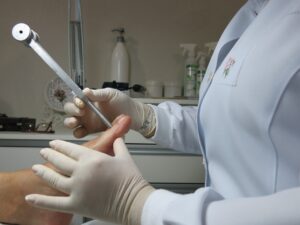Pre-Podiatry

Podiatry is a branch of medicine that focuses on the study, diagnosis, and medical or surgical treatment specific to the foot, ankle, and lower extremity. A podiatrist is a doctor but will not attend a traditional medical school, instead they graduate from their own professional school, are titled as a “DPM” (doctor of podiatric medicine), and join their own professional organizations. They can prescribe medication, order diagnostic tests, perform surgery, and often work in collaboration with other specialists. Some of the contions podiatrists may work with are fractures and sprains, nail disorders, bunions, hammertoes, heel pain, arthritis, growing pain, neuromas, and complications from diabetes. In the United States, podiatrists are licensed and regulated by state governments in the same manner of a physician, dentist, or optometrist. For more information on Podiatry, visit the website of The American Associate of Colleges of Podiatric Medicine (AACPM) at https://aacpm.org/.
Podiatry School Prerequisite Courses
In general most programs require:
- One year of Biology with labs
- One year of General Chemistry with labs
- One year of Organic Chemistry with labs
- One semester of Biochemistry
- One year of Physics with labs
- Physiology with lab
- Psychology
- Sociology
- Statistics
Other coursework that may be beneficial:
- Immunology
- Anatomy
- Second semester of Biochemistry
Applying to Podiatry School
Medical College Admission Test (MCAT): A student interested in podiatry school will typically prepare for the Medical College Admission Test (MCAT) during their third year (fall/winter) and then take the exam in spring/summer of following the third year. For more information visit the MCAT website.
Letters of Recommendation: Pre-podiatry students should be prepared to ask two science professors and one non-science professor for letters of recommendation. Schools may require a letter to be from a podiatrist. Schedule a meeting with the professors to directly ask them to write the letters. Don’t just drop in as the request might get shuffled off and forgotten. Be intentional about asking. Bring a list or short narrative of the work you completed in the classes taken under the professor. Professors see many students over the years and don’t always remember specific course assignments or course experiences like you will. Remind them of these experiences. Provide an estimated date for submission of their letters. Give your professors enough time to write a thoughtful letter.
Personal statement: A personal statement is a well thought out explanation of why podiatry is right for you based on the experiences that have led you to this conclusion. Experiences from your life, work, research, or shadowing that are pertinent to explaining your call to podiatry need to be included as part of this statement. Journaling is a convenient way of keeping track of formative experiences and their impact on you as they occur.
Shadowing and experiences: It is important for students to accumulate significant experience shadowing, volunteering, or clinical work. Specifically, these hours should be within a podiatry clinic rather than the general medical or orthopedic field.
Application timeline: The application process to medical school begins in May/June of the third year and the primary application should be submitted to the American Associate of Colleges of Podiatric Medicine Application Service (AACPMAS) no later than July. Secondary applications begin to arrive in August or September of the senior year, and they must be completed and returned immediately.
Podiatry Schools Attended by Butler Graduates
Recent Butler graduates have attended the following Podiatry Schools:
- Des Moines University
- Kent State University
- Temple University
- Touro University

